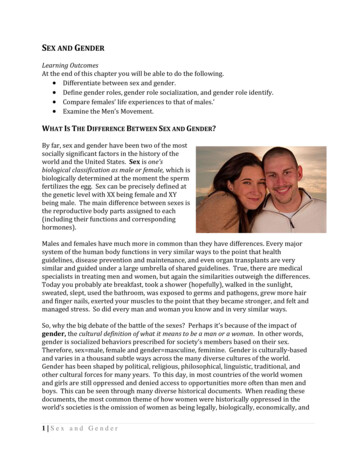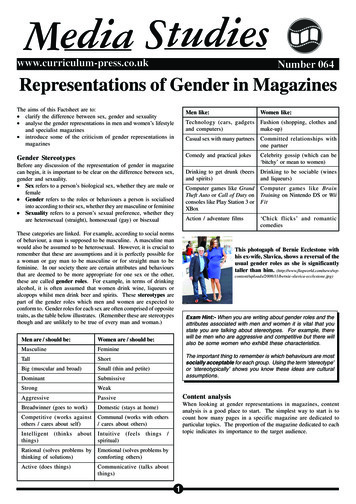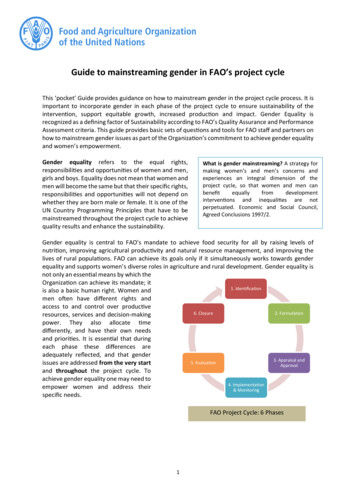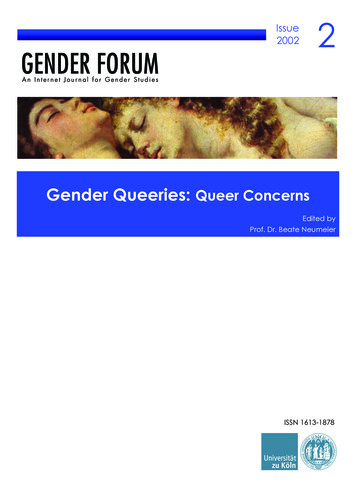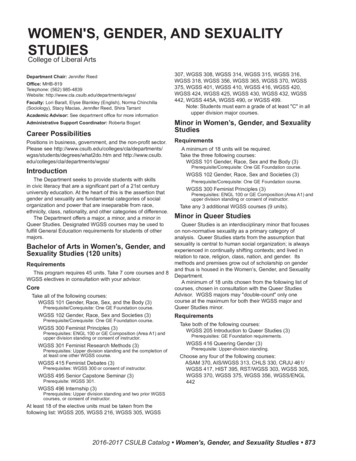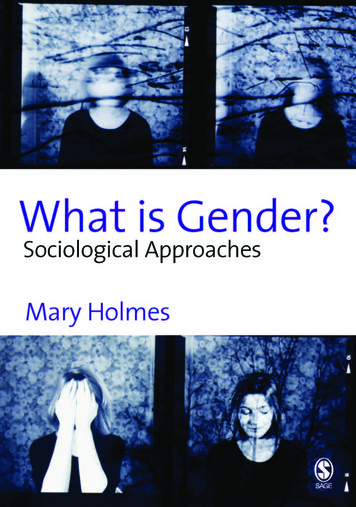
Transcription
What is Gender?This SAGE ebook is copyright and is supplied by NetLibrary. Unauthorised distribution forbidden.
This SAGE ebook is copyright and is supplied by NetLibrary. Unauthorised distribution forbidden.
What is Gender?Sociological ApproachesMary HolmesThis SAGE ebook is copyright and is supplied by NetLibrary. Unauthorised distribution forbidden.
Mary Holmes 2007First published 2007Apart from any fair dealing for the purposes of research orprivate study, or criticism or review, as permitted under theCopyright, Designs and Patents Act, 1988, this publicationmay be reproduced, stored or transmitted in any form, or byany means, only with the prior permission in writing of thepublishers, or in the case of reprographic reproduction, inaccordance with the terms of licences issued by the CopyrightLicensing Agency. Enquiries concerning reproduction outsidethose terms should be sent to the publishers.SAGE Publications Ltd1 Oliver’s Yard55 City RoadLondon EC1Y 1SPSAGE Publications Inc.2455 Teller RoadThousand Oaks, California 91320SAGE Publications India Pvt LtdB 1/I 1 Mohan Cooperative Industrial AreaMathura RoadNew Delhi 110 044SAGE Publications Asia-Pacific Pte Ltd33 Pekin Street #02-01Far East SquareSingapore 048763Library of Congress Control Number: 2006939135British Library Cataloguing in Publication dataA catalogue record for this book is available from theBritish LibraryISBN 978-0-7619-4712-7ISBN 978-0-7619-4713-4 (pbk)Typeset by C&M Digitals (P) Ltd., Chennai, IndiaPrinted in Great Britain by The Cromwell Press Ltd,Trowbridge,WiltshirePrinted on paper from sustainable resourcesThis SAGE ebook is copyright and is supplied by NetLibrary. Unauthorised distribution forbidden.
ContentsAcknowledgementsvi1Introduction to the sociology of gender12How different are women and men?183Is gender something that we do?404How can gender best be explained?635Is gender about bodies?876What are the politics of gender?1107How is gender intertwined with class?1298How is gender intertwined with ‘race’?1499Conclusion: So what is gender?171References183Index203This SAGE ebook is copyright and is supplied by NetLibrary. Unauthorised distribution forbidden.
AcknowledgementsMuch of this book was written within the warmth of supportiveness of thesociology department at the University of Aberdeen. I am indebted to my colleagues there in so many ways and I continue to miss their laughter.The bookwas finished at Flinders University and I apologize for ruining some of ourpleasant lunches by making everyone discuss things like symbolic capital. I amvery grateful to colleagues at those and other universities who read draft chapters for me: Alex Howson, Karen O’Reilly, Chris Beasley, Paula Black, JaneHaggis, Heather Brook, and Mike Hepworth. Thank you to CarolynCorkindale, the Department of Sociology’s excellent research assistant atFlinders, for tracking down many of the references and doing much tidying upof the manuscript.The faults, of course, remain mine. I commend you to thosefaults as points where as readers you can engage with the text and say: ‘Hangon a minute, I’m not so sure about that’. It is that engagement which will makethe book useful.I had no leave to help me complete this book, apart from a few weeks atthe end of one semester, so I hope you all feel very sorry for me. Thank youto Brent for always feeling sorry for me when I needed it. I am glad that I wasable to complete this book and writing it reminded me of all the students Ihave taught and how much I learnt from them. So thank you to them. For students or colleagues who might read this, email me and tell me if you like thebook or hate it, or have questions.That is what I think it should be about.This SAGE ebook is copyright and is supplied by NetLibrary. Unauthorised distribution forbidden.
1Introduction to the sociologyof genderChris got up and went to the bathroom. Leaving pyjamas on the floorand turning on the shower, Chris stepped into the water. It was not ahair-washing day, so after a quick rub with the soap it was time to getout and dry off. After towelling and applying hair putty to the new shorthaircut, Chris dabbed on some moisturising lotion and went to getdressed. Nothing special was happening today so jeans and a T-shirtwould be fine. The only choice really to be made was betweenbasketball boots or sandals.This is a paragraph I made up. When you read it I imagine that youassumed either that Chris was a woman, or that Chris was a man. YetChris is a shortened name which both Christophers and Christines useand I have not used any pronouns to indicate sex. There is nothing inthis description that definitively identifies masculinity or femininity.Youmay protest that ‘real’ men do not use moisturiser, or that women are lesslikely to have short hair. Nevertheless, most people know of men whoare into face creams and other such products and women who haveshort hair.Your decision is not defensible, but the point is that you madea decision. We do not know how to think about people as neutral; wealways think about them as women or as men and we interact with themaccordingly. If you decided Chris was a woman, go back and read theparagraph again and imagine Chris is a man. Does that change how youread it or what you think about Chris? Do you think it ‘typical’ of a manjust to leave his pyjamas on the floor; do you feel a little titillated byimagining a naked man in the shower? Try to continue describingChris’s day without giving away whether Chris is a man or a woman. Itis very difficult to do.We live in a world which is organized around the idea that womenand men have different bodies, different capabilities, and different needsand desires.This book examines these assumptions, drawing on sociological and related approaches to understand how and why the social worldThis SAGE ebook is copyright and is supplied by NetLibrary. Unauthorised distribution forbidden.
2Chapter 1is arranged around such gender distinctions. This introduction beginsthat task by defining key terms, then looking briefly at the history ofgender within sociology. In some senses the rest of this chapter outlineswhat the book is not about – or, to put it more positively, why I focuson the issues that appear in the book and not on facts about inequalitiesor on media images of gender. I want to explain why I say so little aboutthese things because long experience of teaching this topic tells me thatpeople come to it with a strong sense of what is important. Many assumethat women and men are equal now and that the media are most crucialin how we now behave as women and men. I want to establish some ofthe bare facts about inequalities and discuss why the media may not beas all powerful as they initially appear. I will then be able to turn to mycentral project of explaining the cultural turn within sociological andfeminist approaches to gender.When the sociology of gender emerged,inequalities between women and men were the focus. Discussion ofwomen’s relative lack of access to wealth and other resources was graduallyovertaken by concerns with language and meaning. The promise andproblems of this shift within ideas about gender are the subject offollowing chapters.Those chapters will make more sense if the key termsused are clearly understood.Defining termsKey words are highlighted throughout the text in bold.The sociology of gender and related knowledge sometimes uses language that may be unfamiliar or have different meanings to those usedin everyday life. Terminology and jargon are the same thing dependingon whether you understand them or not. Having specific terms withspecific meanings is useful as a shorthand way of dealing with ideas thatcan otherwise take some time to explain. Defining the most crucialterms can serve as a way to introduce the kinds of things with whichthis book is concerned. The first thing to deal with is the distinctionsociologists have made since the 1970s between sex (biological differences between males and females) and gender (socially produceddifferences between being feminine and being masculine). Later thebook will return to the question of how distinct gender is from sex.However, it is generally agreed that gender differences are to be understood as a central feature of patriarchy, a social system in which menhave come to be dominant in relation to women.There are, as we shallsee, questions around to what extent gender is imposed on individuals asa result of the material conditions and social structures in which theylive. Within sociology, ‘material’ has meant various things. Karl Marx,whose thought forms a good deal of the foundations of sociology, wasThis SAGE ebook is copyright and is supplied by NetLibrary. Unauthorised distribution forbidden.
Introduction to the Sociology of Genderparticularly concerned with how societies were organized, or structured,around meeting material needs, such as the need for food and shelter. Heargues that people’s lives were determined by how a society organizedthe production of the things needed to survive.This was an emphasis onthe economic, meaning the producing, managing and distributing ofresources within society. Marx argued that industrialization instituted anew economic system called capitalism based on employers exploitingworkers’ labour (only paying a wage not a share of the profits) and accumulating for themselves the wealth resulting from selling things.However, material is a term that has taken on broader meanings in morerecent years, especially with regard to gender. Now it is maintained thatthe material may include a wider range of things, not just the things weneed to survive but our bodies as things (Rahman and Witz, 2003).Yetwidening what is meant by material has been only part of the story ofdeveloping understandings of gender. For sociologists the key has beento see gender as a social construction (something created by the socialenvironment).An appreciation of how material conditions produce gender will be discussed but this book also looks at the importance ofdiscourses (systematized ways of talking and thinking) in how genderoperates. Medical and scientific discourses, for example, have beenimportant in constructing gender. It is important to understand the partthat ideas and meanings play in the social construction of femininity andmasculinity. There are of course sociological discourses on gender andour discussion begins with a history of these ideas.The history of genderClassic sociology and other social theory contain little attention to thesocial differences between women and men. Marx, Weber andDurkheim are not noted for their insights into ‘sex’ inequality (the wordgender was not known to them in its present usage) and in fact tendedmostly to consider women’s subordinate social role as a natural ‘given’(Sydie, 1987). Durkheim thought of modernity’s greater distinctionbetween ‘sex roles’ as a functional, biologically based evolution resultingfrom the progressive forces of a shift to organic solidarity.To translate, heargued that as society became more complex, more distinct differencesin body and mind emerged between women and men; they specializedin their roles and this made the division of labour more efficient andsociety stronger. Weber also saw women’s dependent social position asfundamentally determined by ‘the normal superiority of the physicaland intellectual energies of the male’ (Weber cited in Sydie, 1987: 59).This marred an otherwise interesting analysis of traditional power aspatriarchal – in the pre-feminist sense of older males exercising traditionalThis SAGE ebook is copyright and is supplied by NetLibrary. Unauthorised distribution forbidden.3
4Chapter 1domination through the family (Sydie, 1987: 51–87). It seems slightlyodd that these thinkers should view ‘sex roles’ as naturally determined,given that they were busy stressing how social forces affected everythingelse. It also seems a little odd given that Weber’s wife Marianne was anotable German feminist and Marx’s daughter Eleanor was involved infeminist politics. Nevertheless these thinkers failed to examine ‘sex’ as animportant social division and this view was long dominant withinsociology (Oakley, 1974). However, this does not mean that inequalitiesbetween women and men were entirely ignored. Marx recognizedinequality between the sexes as a problem, albeit a problem of secondaryimportance to capitalist exploitation of workers. Marx’s friend andcollaborator Frederick Engels did attempt a Marxist explanation ofwomen’s subordination (see Chapter 4). There was also a tradition ofwomen writing about women’s social position. There was MaryWollstonecraft (1985/1792) in the eighteenth century (see Chapter 4),and Harriet Martineau, in the nineteenth century, who also producedthe first book on sociological methods (see Hill and Hoecker-Drysdale,2001). In addition the highly influential Chicago School of sociologycontained at least a dozen women from its establishment in the 1890s,including the well-known sociologist Jane Addams.These women wereprofessional sociologists actively researching and writing on a range ofissues, including many relating to women’s place in society (Delamont,1990: 139–159).Yet little or no reference is made to these women andmore recent understandings of gender are often seen as beginning withSimone de Beauvoir’s (1988/1949) philosophically based treatise, TheSecond Sex. In her famous statement that ‘[o]ne is not born, but ratherbecomes, a woman’ (de Beauvoir, 1988/1949: 295), she established a coreprinciple of most subsequent efforts to understand gender inequalities.It was not nature but society or ‘culture’ that made women (and men)what they were.In the 1950s and early 1960s Functionalism was largely dominantwithin sociology and it contributed to sociological understandings ofdifferences between women and men as socially constructed. Whilesocial construction involves structures such as class systems andinstitutions, the term principally refers to the processes by which ideasabout how things should work are made into social reality. Before theconcept of ‘gender’ came into sociological usage in the 1970s, mid-centuryfunctionalists talked about ‘sex role differences’.Their argument could besummarized as claiming that sex role differences continue to existbecause they function to promote social stability. Whether this was anintended (manifest) or unintended (latent) function of sex role differencesdid not seem to be of major interest to functionalists.The focus of functionalist work was on understanding the ‘complementaryroles’ performed by women and men as they function to keep societyThis SAGE ebook is copyright and is supplied by NetLibrary. Unauthorised distribution forbidden.
Introduction to the Sociology of Genderrunning smoothly. American sociologist Talcott Parsons is the majorfigure within twentieth century functionalism. It is Parsons’s (see Parsonsand Bales, 1956) views of women and men’s ‘complementary roles’ thatare taken as the key statement of functionalist ideas about gender.Writing in the 1950s, Parsons argues that modern social life, and inparticular the modern organization of work as separate from home,means that someone needs to stay home to care for young children andperform the important early socialization of human infants. For highlycomplex and not entirely clear reasons associated with the workings ofsocial groups, this emotional ‘expressive’ role is assigned to women andthe rational and ‘instrumental’ (goal-focused) role of paid work is associatedwith men.These different ‘sex roles’ become the social norms and Parsonscarefully describes how children become socialized into them.Therefore,Parsons’s theory is very much sociological in looking not to nature butto social groups and social processes such as socialization to explainwomen’s and men’s different social positions. In the 1950s and 1960s,others using his work to understand sex roles tended to ignore thissociological position and assume that the expressive/instrumentaldichotomy was in some form an expression of natural differences(Connell, 2002: 123). Though Parsons may have gone beyond this, hiswork offered more of a description of current gender expectations thanan explication of the inequalities accompanying the differing sex roles.Parsons describes the ideal American family of the 1950s and does so ina way that justifies, rather than is critical of, this very historically andculturally specific example of gender roles. Parsons implies that this isthe best way of organizing family life in response to modern socialconditions, but for whom is it best? Since Parsons, much sociology ofthe family has focused more on how the breadwinner/housewife modelof family life has been restrictive for many women. For others, it hasremained a luxury they cannot afford because only those families wherethe men earn high wages could afford for the wife to stay at home.Other alternatives to the nuclear family are similarly ignored or devalued.Although Parsons himself does not discuss other cultures in any detail,he draws on the work of fellow contributors to the book to back hisclaim that a nuclear-style family still seems to function well and maintainsocial stability within many other societies (Parsons and Bales, 1956).Thefact that the content of sex roles is different in other cultures does notnecessarily challenge Parsons’s overall argument that it is complementarity –the fact that one sex is assigned opposite tasks to the other – which isfunctional. However, as discussed in Chapters 1 and 2, anthropologicalresearch can illustrate that in some other cultures women’s and men’sroles are similar not opposite (for example both women and men maycontribute to child rearing), and such an arrangement can also supportstability. Parsons’s focus on the way in which the sexes complement eachThis SAGE ebook is copyright and is supplied by NetLibrary. Unauthorised distribution forbidden.5
6Chapter 1other also fails to consider how and why the different roles have cometo be valued differently. Functionalism does not explain why instrumental roles are more highly regarded within modern western society. Theneed for social stability was seen as justification of the continuance ofsuch sex roles, and though changes in those roles were explored theywere often construed as threatening that stability.The idea that ‘stability’may not be beneficial to women constrained within traditional roles didnot seem to occur to the functionalists. The importance attached tosocial stability prevented functionalists from developing a real analysis ofhow some social actors and groups might not benefit from the continuance of the sharply defined roles identified.Various feminist sociologistsbegan systematically to examine differences between women and menas socially produced. It is from this key departure point in the 1970s thatthis book begins its travels.It is hard for today’s students of gender, faced with mountains ofrelevant books, to imagine the paucity of decent literature about womenthirty to forty years ago. Into this void the new ‘wave’ of feminists beganto launch their considerations of the causes and state of inequalitiesbetween women and men (see Chapter 4 and Chapter 6). It is also oftendifficult to comprehend how many changes have taken place for womeneven since the 1960s. Equal Pay legislation has been passed, women havemore control over if and when they reproduce, a university education ismore than a way for middle class women to meet a husband, job opportunities have improved, and so on. But are women and men equal now?Material inequalities: are women and menequal now?If you are a young woman you may feel that you have a lot of choiceabout what you do with your life. It probably seems like you will havemore or less the same opportunities in life as your brothers and/or malefriends.Young men reading this might feel that women can do whateverthey want to these days and that talking about inequalities is out of date.Certainly the world has changed. Read some history or talk to yourmothers and grandmothers and you will quickly appreciate that youngwomen today are likely to have more education, better job opportunities and more independence than young women did forty or fifty yearsago. Young women may be partly right in suggesting that they havemuch the same opportunities as men their age.In terms of education young women are likely to have completedsecondary school and probably did better than the boys.At university orcollege you are likely to see as many undergraduate women on campusas men, with women continuing to do slightly better. In the UnitedThis SAGE ebook is copyright and is supplied by NetLibrary. Unauthorised distribution forbidden.
Introduction to the Sociology of GenderKingdom, for example, six times more women enrolled in highereducation in 2003/04 than in 1970/71, so that around 59 per cent ofundergraduates are now women (Office for National Statistics, 2006:38). While girls in wealthier nations are able to take advantage of atleast a good basic education, in other areas of the world educationalopportunity for girls can be limited. Non-formal, local and traditionalforms of learning may exist in many places but formal westernized typesof education are likely to bring greater status and social rewards. Theamount of formal education varies greatly between different regions ofAfrica. Southern Africa has for some time demonstrated little differencebetween boys and girls in length of schooling. Early twenty-first centuryfigures show boys getting 10.9 years and girls 10.4 years at school(African Development Bank, 2002:Table 1.8). However, in Western andCentral Africa only 51 per cent of primary school age girls actuallyattend primary school compared to 59 per cent of boys. At secondaryschool this drops to just over one in five of secondary age girls attending,while one in four boys of secondary age attend (UNICEF, 2006: 121).India, on the whole, provides more education. Primary school isattended by 73 per cent of girls of primary school age, compared to 80per cent for boys (UNICEF, 2006: 121). It has a strong formal educationaltradition and, as with many western nations, women higher up the casteand class hierarchy tend to be well educated. In poorer families,however, girls will probably leave school fairly young, most likely toenter a marriage arranged for them.They will then become responsiblefor most of the domestic work in the home of their new parents-in-law.For such poorer families, manual work and the domestic support of thatwork may be crucial to survival and families need children to startbringing in money as soon as possible. But this does not explain whygirls are expected to do the domestic work; that expectation is betterunderstood in terms of a culture which values the welfare of the groupand especially expects women to contribute to that group welfare ratherthan pursue individual goals. Thus caring roles at home are stillpromoted as the proper course for many less privileged women (Kodothand Eapen, 2005; Mukhopadhyay and Seymour, 1994).Among more privileged groups in the western world, universitygraduates of both sexes look forward to getting a ‘good’ job at the endof their degree. However, the subjects they take in doing their degreesare likely to differ and, therefore, their job options will differ. Have alook around a sociology class – I bet there are more women than men.Try visiting an English or history lecture and you will probably findfewer men there. Then go over to a physics lecture to see if the menoutnumber the women, and finally pop in to the engineering departmentwhere you may be able to count the women on one hand (e.g. seeDepartment of Education, Science and Training, 2005: 32; EqualThis SAGE ebook is copyright and is supplied by NetLibrary. Unauthorised distribution forbidden.7
8Chapter 1Employment Opportunities Commission, 2006: 8; National ScienceBoard, 2006). These gender differences in choice of subject will affectwhat sorts of jobs graduates will be able to get.Although there are manygood jobs that sociology and English graduates might end up with, it isnot the same sort of direct route into high paying, high status work asstudying engineering.The women who do engineering may not initiallynotice any difference between themselves and their male peers, but theymay discover that the men in the class find it easier to get jobs than thewomen. Once in jobs it may become clear that the men are promotedahead of women at a similar stage and with similar ability. Also womenengineers may note that the men are not asked how they are going tocombine a career with having a family.These are some of the factors incontinuing pay gaps between women and men in science and engineering(Prokos and Padavic, 2005). Continuing beliefs about women’s responsibility for their families play a part in determining to what extentwomen participate in paid work.In most of South Asia, the Middle East and North Africa, women’seconomic participation rate is only around 30 per cent, compared toaround 45 per cent in OECD (high income) countries (World Bank,2006).This means that in most cases women are less likely to have a paidjob than men. Even where women now form a large portion of theworkforce they continue to work in different jobs, under differentconditions and generally receive less pay. Sociologists refer to the dividingup of work into jobs thought of as ‘men’s jobs’ and those thought of as‘women’s jobs’ as the sexual division of labour or (the more recent term)the gendered division of labour. The vertical division of labourby gender means that women are rare in the higher positions withinoccupations. This is especially true of influential managerial positions.In the Fortune 500 (America’s top 500 companies) in 2005 only 16.4per cent of all corporate officer (top management) positions were heldby women. Over half of these companies had less than three womencorporate officers in 2005 (Catalyst, 2006: 6, 9). The invisible barriersthat seem to prevent women being promoted to upper management arereferred to as ‘the glass ceiling’ (see Hymowitz and Schellhardt, 1986).Yet addressing and overcoming such barriers would not necessarilybring equality for all women because of the horizontal gender divisionof labour, which means that work is divided in gendered ways acrossoccupations.This has obvious implications for how wealth is distributedbetween women and men.Evidence indicates that women are poorer than men. They do notearn as much and generally have less access to the material rewards availablein society. At the beginning of the twenty-first century in WesternEurope, North America and Australasia, women earn around 75 to 90per cent of the average man’s wage.World wide the figure drops so thatThis SAGE ebook is copyright and is supplied by NetLibrary. Unauthorised distribution forbidden.
Introduction to the Sociology of Genderon a global level women earn around 60 per cent of the male average(Connell, 2002: 2; United Nations Statistics Division, 2005). Through acreative use of job titles, job descriptions and special ‘bonuses’ it is possible to evade equal pay legislation (where it exists) and to pay a manmore than a woman who is, effectively, doing the same job. In poorercountries it is poverty rather than low pay that is the issue. The phrase‘feminization of poverty’ was conjured up by the United Nationsto refer to an apparent trend in which an increasing number of thoseliving in poverty are women, and that poverty is growing more severe.The reasons for such a trend are complex and debated.They may rangefrom the costs of women’s unpaid work, their related lack of educationaland economic opportunities (including access to land and other resources),the rise of HIV/AIDS among women, and the ways in which globalization leads to new ways of exploiting women in developing countries(Barker, 2005).Not everyone in developing countries is poor, and of course povertyexists in developed countries too. Women in developed and developingnations are more likely to be poor partly because of their caringresponsibilities, which often make them reliant on social services.As theseservices are cut back women are often required to do more caring and yetthere is less financial and other support available (Kehler, 2001). Thefeminization of poverty in wealthy nations may, however, be relative ratherthan absolute. Absolute poverty is about not being able to meet basicsurvival needs, for example not having enough food to eat. The mostrecent reliable statistics suggest that such poverty is still common inIndia, for example, where 36 per cent of women aged 15 to 49 wereundernourished according to a 1998–99 survey (International Institute forPopulation Sciences and ORC Macro, 2000: 244). Relative poverty ismore common in the West, where you may be able to eat, but do not haveenough money to share in the other benefits your society has to offer. Forexample, you may not be able to afford a television or holidays; this makesyou poor relative to those around you.And again it is mostly women whoare poor, especially single mothers whether never married or divorced.When relationships break up it is usually the women who get custody ofthe children. Although welfare payments may offset some of the financialburdens women face after divorce, in most cases women are soon poorerthan their ex-partners. Even where laws require a couple’s assets to behalved and men to pay maintenance, men may fail to pay; never marriedand divorced women’s earning opportunities are likely to be restricted bychild care responsibilities, and their finances may be tight because they arebearing most of the cost of raising the children (for example, Uunk, 2004;Yamokoski and Keister, 2006).The consequences of poverty for women range from the extremecase of starvation – or at very le
sociologists have made since the 1970s between sex (biological differ-ences between males and females) and gender (socially produced differences between being feminine and being masculine). Later the book will return to the question of how distinct gender is from sex. However,it is




